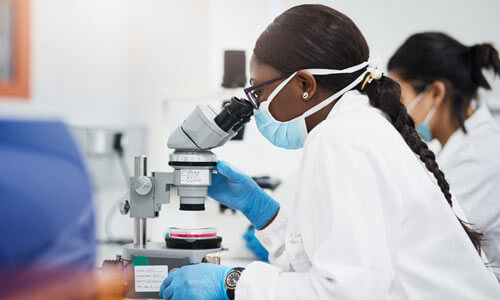HIV and AIDS
Overview
AIDS (acquired immunodeficiency syndrome) is caused by the human immunodeficiency virus (HIV). This kills or impairs cells of the immune system and progressively destroys the body's ability to fight infections and certain cancers. HIV is most commonly spread by sexual contact with an infected partner. Another important means of spreading HIV is contact with infected blood from contaminated needles, syringes, or other drug paraphernalia.
The term AIDS applies to the most advanced stages of an HIV infection. The current definition of AIDS includes all HIV-infected people who have fewer than 200 CD4+ T cells (healthy adults usually have CD4+ T-cell counts of around 800 or more.) In addition, the definition includes HIV-infected people who have been diagnosed with one or more clinical conditions (including opportunistic infections and certain cancers) that affect people with advanced HIV disease.
According to the CDC, an estimated 1 million adults and adolescents are living with HIV/AIDS in the United States. The AIDS epidemic still rages out of control in many areas of the world.
How is HIV/AIDS transmitted?
Sexual contact
HIV is spread most commonly by sexual contact with an infected partner. The virus enters the body through the lining of the vagina, vulva, penis, rectum, or mouth during sexual activity.
Blood contamination
HIV may also be spread through contact with infected blood. However, due to the screening of blood for evidence of HIV infection in the U.S., the risk of acquiring HIV from blood transfusions is extremely low.
Needles
HIV is often spread by sharing needles, syringes, or drug use equipment with someone who is infected with the virus. Transmission from patient to healthcare worker, or vice-versa through accidental sticks with contaminated needles or other medical instruments, is rare.
Mother-infant
HIV also can be spread to babies born to, or breastfed by, mothers infected with the virus.
HIV/AIDS cannot be spread through:
-
Saliva
-
Sweat
-
Tears
-
Casual contact, such as sharing food utensils, towels, and bedding
-
Swimming pools
-
Telephones
-
Toilet seats
-
Biting insects (such as mosquitoes)
What are the symptoms of HIV/AIDS?
Some people may develop a flu-like illness within a month after exposure to the HIV virus. But many people do not develop any symptoms at all when they first become infected. In addition, the symptoms that do appear, which usually disappear within a week to a month, are often mistaken for those of another viral infection. These may include:
-
Fever
-
Headache
-
Malaise
-
Enlarged lymph nodes
Persistent or severe symptoms may not surface for 10 years or more after HIV first enters the body in adults, or within 2 years in children born with an HIV infection. This "asymptomatic" period of the infection is highly variable from person to person. But, during the asymptomatic period, HIV is actively infecting and killing cells of the immune system. Its most obvious effect is a decline in the blood levels of CD4+ T cells (also called T4 cells)—a key immune system infection fighter. The virus initially disables or destroys these cells without causing symptoms.
As the immune system deteriorates, complications begin to surface. The following are the most common complications, or symptoms, of AIDS. However, each individual may experience symptoms differently. Symptoms may include:
-
Lymph nodes that remain enlarged for more than 3 months
-
Lack of energy
-
Weight loss
-
Frequent fevers and sweats
-
Persistent or frequent yeast infections (oral or vaginal)
-
Persistent skin rashes or flaky skin
-
Pelvic inflammatory disease that does not respond to treatment
-
Short-term memory loss
-
One or more infections (opportunistic infections) related to having a weakened immune system. These include tuberculosis and certain types of pneumonia.
Some people develop frequent and severe herpes infections that cause mouth, genital, or anal sores, or a painful nerve disease known as shingles. Children may have delayed development or failure to thrive.
During the course of the HIV infection, most people experience a gradual decline in the number of CD4+ T cells. Though some individuals may have abrupt and dramatic drops in their counts.
The symptoms of an HIV infection may resemble other medical conditions. Always talk with your healthcare provider for a diagnosis. Rapid diagnostic tests are available and early diagnosis is important.
How is HIV/AIDS diagnosed?
Early HIV infection often causes no symptoms, and must be detected by testing a person's blood for the presence of antibodies—disease-fighting proteins—against HIV. These HIV antibodies generally do not reach levels high enough to detect by standard blood tests until 1 to 3 months following infection, and may take as long as 6 months. People exposed to HIV should be tested for HIV infection as soon as they think they may have been exposed to HIV.
When a person is highly likely to be infected with HIV and yet antibody tests are negative, a test for the presence of HIV itself in the blood is used. Repeat antibody testing at a later date, when antibodies to HIV are more likely to have developed, is often recommended.
Treatment for HIV/AIDS
As with many other conditions, early detection offers more choices for treatment. Today, there are medical treatments that not only can slow down the rate at which HIV weakens the immune system, but also may keep HIV in check so that the individual has a chance to live a normal life span. Unfortunately, there is no cure for an HIV infection. Talk with your healthcare provider for more information regarding various drug therapies for the treatment of HIV/AIDS.
Are we getting close to finding a vaccine for AIDS?
HIV is still spreading worldwide. Research continues to provide more insight to possible vaccine strategies, but no cure is available.
Basics
Research Shows Biomedical Discoveries Underpin Good Health


